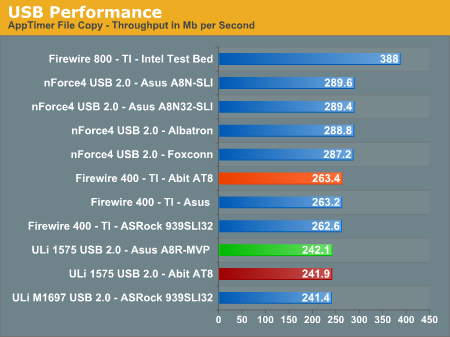Abit AT8: µGuru comes to the RD480
by Gary Key on March 10, 2006 12:05 AM EST- Posted in
- Motherboards
Firewire and USB Performance
After looking at many options for Firewire and USB testing, we finally determined that an external USB 2.0, Firewire 400, and Firewire 800 hard disk would be a sensible way to look at USB and Firewire throughput.
Our first efforts at testing with an IDE or SATA drive as the "server" yielded very inconsistent results, since Windows XP sets up cache schemes to improve performance. Finally, we decided to try a RAM disk as our "server", since memory removed almost all overhead from the serving end. We also managed to turn off disk caching on the USB and Firewire side by setting up the drives for "quick disconnect" and our results were then consistent over many test runs.
We used 1GB of fast 2-2-2-5 system memory set up as a 450MB RAM disk and 550MB of system memory. Our standard file is the SPECviewPerf install file, which measures 432,533,504 bytes (412.4961MB). After copying this file to our RAM disk, we measured the time for writing from the RAM disk to our external USB 2.0, Firewire 400, or Firewire 800 drive using our Windows bases timing program. The copy times in seconds were then converted into Megabits per second (Mb) to provide a convenient means of comparing throughput. Higher Rates therefore mean better performance in this particular test.
The Abit board offers a TI based IEEE 1394 Firewire option with performance equal to that of other TI solutions. The USB 2.0 performance is consistent with other ULi based controllers and continues to lag behind the NVIDIA nForce4 chipset solutions in throughput.
After looking at many options for Firewire and USB testing, we finally determined that an external USB 2.0, Firewire 400, and Firewire 800 hard disk would be a sensible way to look at USB and Firewire throughput.
Our first efforts at testing with an IDE or SATA drive as the "server" yielded very inconsistent results, since Windows XP sets up cache schemes to improve performance. Finally, we decided to try a RAM disk as our "server", since memory removed almost all overhead from the serving end. We also managed to turn off disk caching on the USB and Firewire side by setting up the drives for "quick disconnect" and our results were then consistent over many test runs.
We used 1GB of fast 2-2-2-5 system memory set up as a 450MB RAM disk and 550MB of system memory. Our standard file is the SPECviewPerf install file, which measures 432,533,504 bytes (412.4961MB). After copying this file to our RAM disk, we measured the time for writing from the RAM disk to our external USB 2.0, Firewire 400, or Firewire 800 drive using our Windows bases timing program. The copy times in seconds were then converted into Megabits per second (Mb) to provide a convenient means of comparing throughput. Higher Rates therefore mean better performance in this particular test.

The Abit board offers a TI based IEEE 1394 Firewire option with performance equal to that of other TI solutions. The USB 2.0 performance is consistent with other ULi based controllers and continues to lag behind the NVIDIA nForce4 chipset solutions in throughput.










42 Comments
View All Comments
Gary Key - Friday, March 10, 2006 - link
Abit plans on this board becoming a value performance leader with the AT8-32x being slightly more upscale in the price range. We will be reviewing this board once it is available. However, given the current price range of the RD580 boards, the RD480 boards are the better value at this time given the incremental performance differences of the RD580 (although this would be my personal choice).
There have been some growing pains with the ATI chipsets but there were also growing pains with the NVIDIA/SIS/VIA/ULi/ALI/Intel/etc. chipsets at product launches also. :) Overall, both the ATI RD480 and RD580 are very good chipsets, the fact the SB600 Southbridge was not available in time for either product launch is where I think ATI failed. This forced the board suppliers to utilize a Southbridge solution (ULi M1575) that was not designed in conjunction with the RD480/580 Northbridge. While it is an excellent Southbridge solution, some of the storage access and timing issues that have been reported and now solved, were not seen on the few SB450 equipped boards. I personally expect the ATI equipped boards to mature quickly and provide an excellent competitive alternative to the nForce boards. This is good for all of us.
n7 - Friday, March 10, 2006 - link
Even with the OCing issues, this is still a far better value Crossfire choice for anyone than the craptastic A8R-MVP